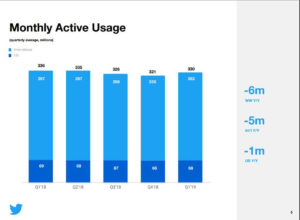Estimated Reading Time [est_time]
4 Effective Ways of Using Twitter Ads Effectively
Twitter, Facebook, Google Ads, Bing, Instagram and Snapchat are all huge digital marketing platforms which are vastly different from one another. Is Twitter advertising in the big internet leagues with Facebook advertising and Google ads? Probably not, but it would be silly to eliminate Twitter just because it doesn’t dominate the top spot. What platform does dominate the top spot? That’s a conversation for a different day.
Believe it or not, when Twitter released their performance report for the first quarter, earlier in the year, the number of active users on the platform has increased to the last quarter from 321 million to 330 million.
Yes, this was down from 336 million on the previous year but still, Twitter have been making a lot of optimisation changes this year and it does seem to be pushing them up the ladder.
(Click on the image for a bigger version)
Whilst there is still plenty of opportunity for Twitter to step up the ladder and be on the same level as the likes of its social media competitors. I think it’s important to step back and focus on what Twitter does well right now.
Twitter as a platform targets a different demographic and focuses on promoting engagement with their users and finding valuable target audiences. Of course, the other platforms do this as well – but Facebook is well known for leading in eCommerce and lead generation, Instagram is heavily driven by image and videos but Twitter is focused around engaging in conversations and with this, influencing brand exposure.
In the past year Twitter’s ad engagements grew by 151% year on year and granted, video advertising was a contributing factor to this success. Perhaps they are noticing the power of video on Instagram and applying their own techniques? Either way, ad engagement is growing and users are continuously tweeting.
In order to use this platform, we need to understand the following:
- Why you should advertise on Twitter?
- Understand who your target audience is
- Establishing a goal
- How to build a successful campaign
1. Why
Conversations:
The first thing I notice when I open my Twitter app, is the variety of conversations as I scroll down the homepage and what I love about using Twitter is the opportunity to join in with any of these conversations. Whether it’s a discussion I am passionate about, interested in or fancy expressing my opinion – Twitter is the platform to turn to for this. We all know President Donald Trump is well known for throwing a spanner in the works from his tweets – if he can step outside of his ‘comfort zone’, I think everyone else can on Twitter.
The key to having a business Twitter account is to connect with potential and current customers – the best way to do this is to choose a topic that resonates with your customer profile. If you sell a variety of luxury hampers, then tailor your ads to this topic for your users to engage with, ask questions and have a conversation around.
Trends and Hashtags
Knowing what popular trends are happening on Twitter, can make it easier for you to decide as a brand whether it’s worth you joining a trending hashtag. Make sure you click through and read some tweets using the trending hashtag first, to understand what context the hashtag is being used in.
The last thing you want is to unintentionally join a conversation which is irrelevant to your audience and your brand.
It’s key to remember there is a huge variety of trends from sporting events #WorldCup to the weekly celebrations such as #FridayFeeling and #ThursdayThoughts. As a brand you need to decide what hashtags are beneficial for you, for your brand and for your goal.
The point of joining a Twitter trend is to track relevant topics and connect with relevant influencers. By joining the right trend you are broadening your brand exposure to a wider audience who are already deep in conversation. Twitter trends are a great way to connect with potential consumers and increase your brand exposure.
Explore
Similar to trends and hashtags, the explore tab is an opportunity for you to see what is happening across a variety of topics – news, sports, fun and entertainment.
Choose wisely and ask yourself what areas are going to help you with your goal? What areas can my ads be tailored to?
2. Who is Your Target Audience?
One of the initial steps in advertising on Twitter is knowing who your target audience is. Who are you trying to reach? How can you do this?
Twitter is a great platform to reach potential consumers and there are many ways you can identify them – Brandwatch recently posted a 5-minute guide to mastering audiences on Twitter:
(Click on the image for a bigger version)
This is a great info-graphic to have access to as you can segment your audiences and really delve into who they are and how you should set up your targeting options based on your findings. When you’ve reached this stage, there is an array or targeting options to really pin down your specific consumers:
- Demographics – gender, age, locations, languages and technology
- Audience features – here you can target specific audiences via keywords, events, behaviors, interests. You can then browse all the different audiences within the specific feature
- Your audiences – choose between tailored and flexible audiences
3. Establishing a Goal
In Twitter’s terms the goal is identified as your campaign objective which can be between ‘tweet engagements’, ‘awareness’, ‘followers’ and various others. The main focus of an objective is to understand what you are aiming to achieve for your brand through advertising on Twitter? How do I get there? How do I measure the results?
This may sound complex, but these are the questions you will ask yourself and with your team before you even open Twitter. If you are unsure on why you should be advertising on Twitter or how it will benefit your brand, then feel free to reach out to Digital Clarity.
Are you trying to increase your brand awareness?
- Show your tweets to as many people as possible to achieve this and avoid narrowing your target audience to be so specific, instead broaden your reach
Are you wanting consumers to download your app?
- Promote your tweets to a targeted audience who are interested in your brand, your product, your discussions as they are the people who are most likely to install your app
Are you wanting to drive traffic to your website?
- If you want people to click through and visit your website, it’s good practice to promote your tweets to people who are likely to do this. This goes back to understanding your audience, so you target the right people to click through. Of course, this is very top level, there is also a deeper layer into this:
- Is your website up to date?
- Does it have a fast load speed?
- Is your landing page relevant to your ad?
- Is there a clear call-to-action
All of these elements will affect your bounce rate and overall user experience.
Once you have a goal mapped out and a plan on how to reach this goal, you can then start advertising on Twitter.
4. Build a Successful Campaign
When you are new to a platform, you want to ensure you are setting up a campaign which follows best practice and evidently is set up in a way to reach your overall goal. How do you do this?
- Categorise and segment your campaigns
- KPIs – how will you measure your campaign success?
- Targeting the right audience
- Set up conversion tracking
These are just a few snippets on how to build a successful campaign. If you would like to find out more on how you can build a successful campaign for any advertising platform, then please reach out to Digital Clarity.









